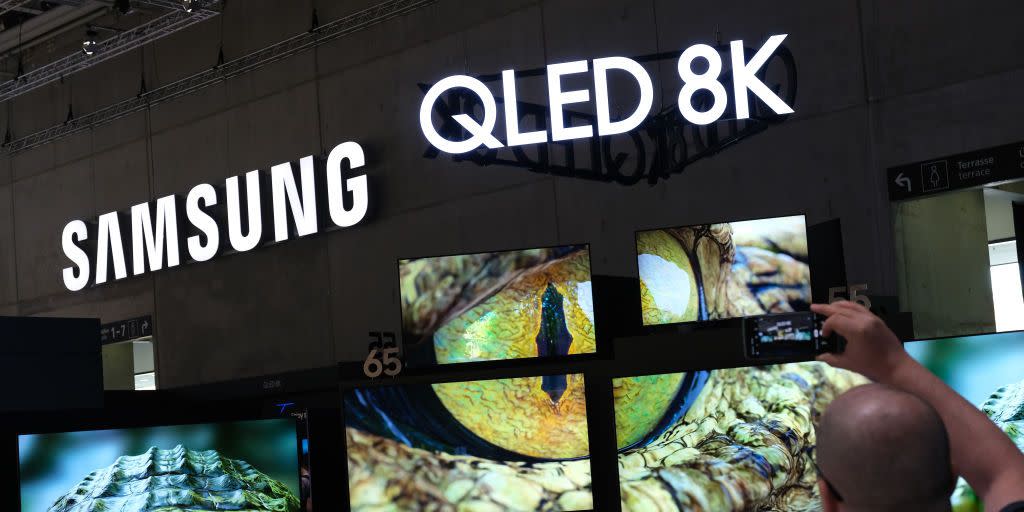What's the Difference Between OLED and QLED TVs?

"Hearst Magazines and Yahoo may earn commission or revenue on some items through the links below."
If you’ve casually looked for a TV lately, you’ve likely been inundated with an assortment of acronyms: 4K, 8K, UHD, HDR, and so on. All of the major manufacturers—Sony, Samsung, LG, and others—use them, along with a host of brand-specific marketing jargon like UltraBlack and Motionflow XR.
But the two most prevalent terms you’ll encounter in the world of high-end TVs are OLED and QLED.
While it’s easy to confuse the two, these similar-sounding terms are actually vastly diverse technologies. But what are they? Why do they sound alike, yet work so differently? And most importantly, which kind of TV tech is right for you?
How Do QLED TVs Work?
QLED is basically the most advanced version of conventional LCD-LED technology. Remember the old “LCD or Plasma?” debate? LCD won handily, and dominates the TV market today. In these TVs, the LEDs, or light-emitting diodes, function as a backlight, which transmits the image through the LCD (liquid crystal display) screen.
But there’s a big problem with LED-LCD TVs: That backlight color—and how it’s rendered as an image by the LCD screen—can vary pretty widely from set to set.
QLED tries to solve that by putting a thin layer, called a quantum-dot filter, between the LED backlight and the LCD screen (that’s where the “Q” comes from). The quantum-dot filter essentially purifies the color of the light coming from the LEDs to get a better, more vivid, and more saturated color. So it’s still a conventional LCD-LED sandwich, just with a fancy quantum-dot layer in there to brighten things up a bit.
How Do OLED TVs Work?
OLED in TVs, meanwhile, is a fundamentally different technology than that of conventional LED-LCD TVs. OLED stands for organic light-emitting diode. In an OLED TV, the pixels emit their own light, which means there’s no need for the LCD screen to display the image. There are three so-called “micro pixels” in each OLED pixel, corresponding to the red/green/blue color matrix used to produce colors.
Which Has the Best Picture?
For now, OLED has better image quality and contrast. In particular, OLED is better at displaying deep blacks, which matters for scenes shot at night or in low light. This is because each OLED pixel can be turned completely off, so there’s no light coming from it at all.
In a conventional LED TV set, the LEDs never completely turn off, so they use dark grays to simulate black. You can see the difference most clearly in night scenes. Last year, for example, many Game of Thrones fans complained they couldn’t make out the epic action in the episode “The Long Night,” from the final season, but OLED TV viewers didn’t have as many problems.
Since OLED pixels are individually controlled, they’re also fast to change color. That’s important for things like gaming, or watching sports or action movies. Plus, OLEDs offer a wider range of viewing angles and, because there’s no LCD screen, the TVs themselves are thinner, which makes for flusher wall-mount setups.
For their part, QLED TVs have better brightness thanks to the quantum-dot filter. That makes them better for rooms with higher levels of ambient light, like a living room with a lot of windows. And QLED TVs are less expensive, a gap that increases with TV size.

Who Makes What?
Generally, Samsung is Team QLED, while the other two major players in the U.S. market—Sony and LG—sell OLED TVs. Both Panasonic and Bang & Olufsen have OLED TVs, but Panasonic stopped selling them stateside in 2016. And at a cool $20,000, B&O’s new BeoVision Harmony won’t be available in the U.S. until October.
QLED is a similarly small brand landscape. Samsung is part of a modest consortium of three manufacturers, called the QLED Alliance, that formed about two years ago. The others are Hisense and TCL, which are much less common in the U.S.
Samsung owns the U.S. trademark to the term QLED TV, so even if other manufacturers use quantum-dot technology, they either need to license it from Samsung (as do Hisense and TCL), or call it something else.
What’s Best for You?
Generally, OLED is the better choice for most situations. When we asked the sales staff at Listen Up, a high-end home-theater store with locations in Colorado and New Mexico, they lauded OLED’s bright colors, better contrast, and wider viewing angles, compared to QLED. The exception is that QLED works better in bright rooms, and is made in larger sizes than most OLED TVs while costing less at a given size.
Again, OLED is ideal for high-motion content like gaming and sports. But don’t pay attention only to basic image technology here; just as with computers for gaming, picture processor speed matters. Frustratingly, manufacturers refer to picture processors only by proprietary marketing names—like LG’s a9 Gen 2, for example—and not clock speed, so you can only compare within a brand, not to other brands. In general, spending more gets you a better processor.
One thing you don’t have to worry about: burn-in, that old bugaboo of plasma TVs, where lots of TV use could lead to a ghostly image permanently glowing on the screen. QLEDs don’t suffer burn-in at all. While OLEDs technically can, unless your TV is tuned in on all day long to a news channel like CNN that has a fixed logo somewhere on screen, the picture changes often enough that you won’t ever suffer from the issue.
What Else Is Coming?
Although OLED has the clear quality edge right now, two new technologies could potentially shift things. MicroLED is also an emissive LED technology that uses miniaturized LEDs. It’s claimed to have the same high-quality pure blacks and contrast as OLED, but with better brightness and zero risk of burn-in.
For its part, the emerging QLED tech is called direct-view quantum dot (DV-QLED). Like OLED, it’s emissive, which could lead to more responsive refresh rates and better contrast. Interestingly, it’s Samsung that’s pushing MicroLED the most, perhaps as a hedge on its QLED bet.
And just to overload you a little more with acronyms, both MicroLED and DV-QLED are TBD. Samsung showed MicroLED prototypes at the 2018 and 2019 CES tech conference in Las Vegas, but hasn’t shared a specific release date. And direct-view quantum-dot LED TVs don’t have a firm release date either though there are rumors of an introduction in the second half of 2020. We haven’t seen any prototypes of this technology in public.
Bottom Line
Like a lot of consumer technology, TVs are constantly changing, and it’s easy to worry that you’ll get stuck with an obsolete model. But don’t fret: Some of the existing stuff is so good, you won’t miss what’s coming. If you’re buying a TV now, OLED is the way to go, unless your primary concern is maximum size for your dollar or you’re putting a TV in a room with a lot of ambient light. In that case, go with QLED.
You Might Also Like

